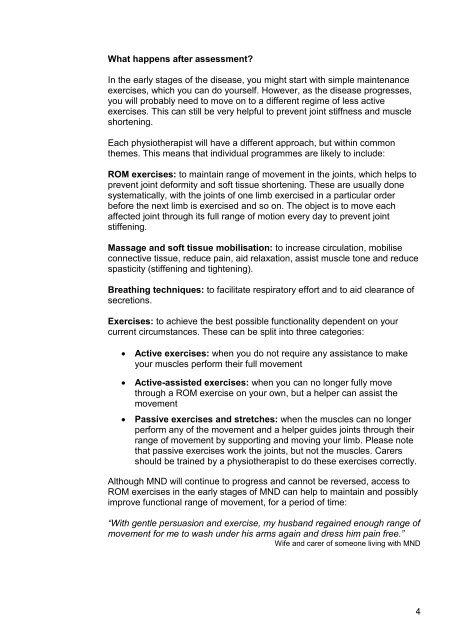Physiotherapy for people with motor neurone disease (MND)
Physiotherapy for people with motor neurone disease (MND)
Physiotherapy for people with motor neurone disease (MND)
You also want an ePaper? Increase the reach of your titles
YUMPU automatically turns print PDFs into web optimized ePapers that Google loves.
What happens after assessment?<br />
In the early stages of the <strong>disease</strong>, you might start <strong>with</strong> simple maintenance<br />
exercises, which you can do yourself. However, as the <strong>disease</strong> progresses,<br />
you will probably need to move on to a different regime of less active<br />
exercises. This can still be very helpful to prevent joint stiffness and muscle<br />
shortening.<br />
Each physiotherapist will have a different approach, but <strong>with</strong>in common<br />
themes. This means that individual programmes are likely to include:<br />
ROM exercises: to maintain range of movement in the joints, which helps to<br />
prevent joint de<strong>for</strong>mity and soft tissue shortening. These are usually done<br />
systematically, <strong>with</strong> the joints of one limb exercised in a particular order<br />
be<strong>for</strong>e the next limb is exercised and so on. The object is to move each<br />
affected joint through its full range of motion every day to prevent joint<br />
stiffening.<br />
Massage and soft tissue mobilisation: to increase circulation, mobilise<br />
connective tissue, reduce pain, aid relaxation, assist muscle tone and reduce<br />
spasticity (stiffening and tightening).<br />
Breathing techniques: to facilitate respiratory ef<strong>for</strong>t and to aid clearance of<br />
secretions.<br />
Exercises: to achieve the best possible functionality dependent on your<br />
current circumstances. These can be split into three categories:<br />
• Active exercises: when you do not require any assistance to make<br />
your muscles per<strong>for</strong>m their full movement<br />
• Active-assisted exercises: when you can no longer fully move<br />
through a ROM exercise on your own, but a helper can assist the<br />
movement<br />
• Passive exercises and stretches: when the muscles can no longer<br />
per<strong>for</strong>m any of the movement and a helper guides joints through their<br />
range of movement by supporting and moving your limb. Please note<br />
that passive exercises work the joints, but not the muscles. Carers<br />
should be trained by a physiotherapist to do these exercises correctly.<br />
Although <strong>MND</strong> will continue to progress and cannot be reversed, access to<br />
ROM exercises in the early stages of <strong>MND</strong> can help to maintain and possibly<br />
improve functional range of movement, <strong>for</strong> a period of time:<br />
“With gentle persuasion and exercise, my husband regained enough range of<br />
movement <strong>for</strong> me to wash under his arms again and dress him pain free.”<br />
Wife and carer of someone living <strong>with</strong> <strong>MND</strong><br />
4


